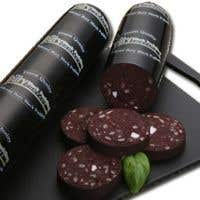This article was also published in the Financial Times.
In its heyday, 60 years ago, there were 146 branches of United Cattle Products across Lancashire and the north of England. Butcher's shops with restaurants attached, UCPs, as they were affectionately known, specialised in the very cheapest cuts, particularly tripe and black pudding.
Their meat never entered our Jewish home but I still have a vivid memory of walking past a branch of UCP in central Manchester with my grandfather en route for a 'coffee dash' at a Kardomah café. It was raining but there was a long queue of housewives outside, and the shop's windows were bedecked with sheets of off-white tripe and dark coils of black pudding.
This experience must have left an indelible mark on my food memory, as I will order tripe whenever I see it on a menu, whether in a spicy version as served in Singapore or, at its very best in my opinion, in a trattoria in northern Italy. This is not just because I relish its comforting flavours, but also because tripe requires such gentle, slow cooking that its correct preparation is a good test of any kitchen.
While tripe, the stomach lining of the cow, is likely to remain a minority taste, black pudding is enjoying a renaissance on many restaurant menus across the world, an evolution that would, I imagine, even momentarily silence the Mancunian housewives who saw it as an essential ingredient in their husband's breakfast.
Black pudding, boudin noir in France or morcilla in Spain are all variations on one of any kitchen's least expensive but most venerable ingredients – the first reference to it in literature, according to the Oxford Companion to Food, is in Homer's Odyssey.
Little has changed in how it is processed in the interim. Blood sausage, its generic name, is dried pig's blood in a casing, the rather neutral flavours of the blood enhanced with pieces of fat, chopped onion and then regional variations: oatmeal in Britain; cream or milk in France, which gives boudin noir a gentler texture; and even almonds, pimentos and parsley in southern Spain.
But what these almost primeval combinations bring to the hands of any imaginative chef are two extra factors.
The first, particularly in the coarser versions that don't fall apart so readily, is a delicious, mouth-filling texture that makes black pudding an adjunct to the most unlikely ingredients. Scallops with black pudding is a well-tried and delicious combination. Cubes of it with beetroot and freshwater perch, as I described last week at Visaandeschelde, Amsterdam, was a first but one I would readily repeat.
The most luxurious ingredients invariably taste best when combined with something far less costly. Menus have long featured truffles with eggs, pasta or rice and I believe that there are likely to be far more variations of black pudding with pork, fish or shellfish (and with sautéed apples it makes a great first course or light lunch dish).
The second factor in the likely rise of the black pudding is that in a world of rapidly increasing food prices, black pudding remains inexpensive. Debbie Pierce, who graduated from her Saturday job selling black pudding on Bury market in Lancashire to start the Bury Black Pudding Co Ltd in 2005 is convinced of this.
'Our initial production was five tons of black puddings a week but it's now over 38 tons', she explained with some pride, 'and we deliver now to most of the major supermarkets nationally. We're having to raise our prices for the first time in two years but that's primarily because of rising grain and petrol prices.
'But what has changed most during this period has been the perception of black pudding. Chefs have opened so many customers' eyes to the fact that black pudding, with less than 5% fat and a high iron content, is a wholesome food at an inexpensive price.'
The chef who has done more than anyone for the reputation of black pudding in the British Isles is Seumas MacInnes, the genial proprietor of Café Gandolfi in Glasgow, Scotland, and the author of The Stornoway Black Pudding Bible. This book, and here MacInnes had to interrupt himself to laugh, has stunned even the most ardent aficionados by selling over 10,000 copies in its first year.
Born on Barra in the Hebrides, where he watched his grandmother and mother make their own black puddings, MacInnes has subsequently lost his professional heart to the black pudding made in Stornoway, Lewis, specifically those made by the butchers Macleod and Macleod. As a result of their long collaboration, which sees MacInnes buy over 25 1.5 kg sticks of black pudding a week, the butchers also make a black pudding and pork sausage especially for him.
'What's so particular about this black pudding', MacInnes explained, 'is that they get the seasoning and the texture just right with just the appropriate amount of oatmeal. It's this twist, which adds a touch of sweetness to an ingredient that seemingly would only taste sour, that makes it such an excellent and unexpected secondary ingredient in so many dishes.'
And it can, as in the best experiments, lead to the most unexpected results. MacInnes's passion for black pudding leads him to combine it with creamy celeriac gratin, pissaladière with anchovies and as fritters with salt cod. But it was the arrival of some courgette flowers from a grower in Arran which prompted him to add crumbled black pudding to ricotta, grated Parmesan, herbs and seasoning before stuffing the flowers and frying them in olive oil. He declares it a great success. I am equally certain that such a dish would never have graced the windows of a UCP.
The Bury Black Pudding Co Ltd, www.buryblackpuddings.co.uk
Café Gandolfi, www.cafegandolfi.com
The Stornoway Black Pudding Bible, £4.99, www.birlinn.co.uk

